A Comprehensive Review of Steel Wire Rope Degradation Mechanisms and Recent Damage Detection Methods
Abstract
1. Introduction
2. Damage Mechanisms for Steel Wire Ropes
2.1. Basic Information about Steel Wire Ropes
2.2. Damage Mechanisms for Steel Wire Ropes
2.3. Previous Research on the Propagation of Damage in Steel Ropes
3. Non-Destructive Detection Methods for Wire Ropes
3.1. Magnetic Flux Leakage (MFL) Method
3.2. Eddy Current Testing (ECT) Method
3.3. Acoustic Emission (AE) Method
3.4. Ultrasonic Guided Wave (UGW) Method
3.5. Radiography
3.6. Visual Inspection/Thermal Imaging
3.7. Comparison of Wire Rope Diagnostic Methods
4. Recent Passive Magnetic Techniques and Sensors
4.1. Active Magnetic Techniques and Sensors Used
4.1.1. Inductive Sensors
4.1.2. Hall Effect Sensors
4.2. Passive Magnetic Techniques and Sensors Used
4.2.1. Magnetoresistive Sensors
4.2.2. Optically Pumped Magnetometers
5. Development Trends in Diagnostics
5.1. Signal Filtering
5.2. Intelligent and Quantitative Rope Inspection
6. Conclusions
- The development of wire rope diagnostics is an issue of great importance for the safety of people using wire rope transport equipment;
- There are many methods of wire rope diagnosis: magnetic flux leakage (MFL), eddy current testing (ECT), acoustic emission (AE), ultrasonic guided waves (UGWs), radiography and vision testing. Each method uses different physical phenomena, and intensive research is being conducted on almost every method;
- It is crucial in the context of wire rope diagnostics to understand the mechanisms of degradation. These mechanisms are closely related to the physical phenomena that accompany them;
- It is impossible to indicate a single effective method for wire rope diagnosis. The characteristics—advantages and disadvantages—of each method presented here demonstrate that, for a comprehensive analysis, testing must be carried out using various methods. Of all the methods presented and described in detail, magnetic methods using the phenomenon of magnetic flux leakage are the most prevalent;
- The most intensive research is currently being conducted on passive magnetic methods using the self-magnetic flux leakage (SMFL) phenomenon;
- The selection of a suitable test method for a particular defect in a wire rope must be accompanied by the selection of a suitable sensor in terms of its operating mechanism and measuring range;
- The resulting diagnostic test signal must be appropriately filtered to assess the true extent of damage to the test object;
- In parallel with the development of passive magnetic methods, intelligent techniques are needed to assist in assessing the technical conditions of steel wire ropes;
- Safe steel-wire-rope working environments and a comprehensive inspection programme are essential for future practical applications.
Funding
Institutional Review Board Statement
Informed Consent Statement
Data Availability Statement
Conflicts of Interest
References
- Feyrer, K. Wire Ropes: Tension, Endurance, Reliability; Springer: New York, NY, USA, 2007; ISBN 978-3-540-33821-5. [Google Scholar]
- Tytko, A. Liny Stalowe: Budowa, Właściwości, Eksploatacje, Zastosowania; Wydawnictwo Naukowe PWN: Warszawa, Poland, 2021; ISBN 978-83-01-21450-0. [Google Scholar]
- Wehking, K.-H.; Feyrer, K.; Klöpfer, A.; Moll, D.; Verreet, R.; Vogel, W.; Winter, S. Laufende Seile: Bemessung und Überwachung; Narr Francke Attempto Verlag: Tübingen, Germany, 2018; ISBN 978-3-8169-8363-7. [Google Scholar]
- Liu, S.; Sun, Y.; Jiang, X.; Kang, Y. A Review of Wire Rope Detection Methods, Sensors and Signal Processing Techniques. J. Nondestruct. Eval. 2020, 39, 85. [Google Scholar] [CrossRef]
- Zhou, P.; Zhou, G.; Zhu, Z.; He, Z.; Ding, X.; Tang, C. A Review of Non-Destructive Damage Detection Methods for Steel Wire Ropes. Appl. Sci. 2019, 9, 2771. [Google Scholar] [CrossRef]
- Mouradi, H.; El Barkany, A.; Biyaali, A. Investigation on the main degradation mechanisms of steel wire ropes: A literature review. J. Eng. Appl. Sci. 2016, 11, 1206–1217. [Google Scholar]
- Mazurek, P.; Kwaśniewski, J.; Roskosz, M.; Siwoń-Olszewski, R. The use of a magnetic flux leakage in the assessment of the technical state of a steel wire rope subjected to bending. J. KONBiN 2018, 48, 493–513. [Google Scholar] [CrossRef]
- Yuan, Y.; Wang, K.; Chen, B.; Qiu, Y. Nondestructive Testing of Coal Mine Wire Ropes Based on Magnetic Sensors. Int. Trans. Electr. Energy Syst. 2022, 2022, e1066163. [Google Scholar] [CrossRef]
- EN 12927; Safety Requirements for Cableway Installations Designed to Carry Persons—Ropes. iTeh Standards: Toronto, ON, Canada, 2019. Available online: https://standards.iteh.ai/catalog/standards/cen/392a2e7b-40c5-4aaa-97ba-b31653b7962e/en-12927-2019 (accessed on 22 January 2023).
- ISO 4309 2017(en); Cranes—Wire Ropes—Care and Maintenance, Inspection and Discard. ISO: Geneva, Switzerland, 2017. Available online: https://www.iso.org/obp/ui/#iso:std:iso:4309:ed-5:v1:en (accessed on 22 January 2023).
- Kaur, D.; Arora, R.; Chhabra, S.; Sharma, S. Characterization of LF and LMA Signal of Wire Rope Tester. Int. J. Adv. Res. Comput. Sci. 2017, 8, 1395–1400. [Google Scholar]
- Houda, M.; Abdellah, E.B.; Ahmed, E.B. Steel wire ropes failure analysis: Experimental study. Eng. Fail. Anal. 2018, 91, 234–242. [Google Scholar]
- Chang, X.; Peng, Y.; Zhu, Z.; Cheng, D.; Lu, H.; Tang, W.; Chen, G. Tribological behavior and mechanical properties of transmission wire rope bending over sheaves under different sliding conditions. Wear 2022, 514–515, 204582. [Google Scholar] [CrossRef]
- Zhang, D.; Feng, C.; Chen, K.; Wang, D.; Ni, X. Effect of broken wire on bending fatigue characteristics of wire ropes. Int. J. Fatigue 2017, 103, 456–465. [Google Scholar] [CrossRef]
- Hongyao, W.; Jie, T.; Guoying, M. A sensor model for defect detection in mine hoisting wire ropes based on magnetic focusing. Insight Non-Destr. Test. Cond. Monit. 2017, 59, 143–148. [Google Scholar] [CrossRef]
- Lei, G.; Xu, G.; Zhang, X.; Zhang, Y.; Song, Z.; Xu, W. Study on Dynamic Monitoring of Wire Rope Tension Based on the Particle Damping Sensor. Sensors 2019, 19, 388. [Google Scholar] [CrossRef]
- Xie, Z.; Shi, P.; Li, Q.; Chen, Z. A study on influence of magnetic field on fracture of ferromagnetic material due to magneto-mechanical coupling effects. Int. J. Appl. Electromagn. Mech. 2019, 59, 235–245. [Google Scholar] [CrossRef]
- Yao, K.; Deng, B.; Wang, Z.D. Numerical studies to signal characteristics with the metal magnetic memory-effect in plastically deformed samples. NDT E Int. 2012, 47, 7–17. [Google Scholar] [CrossRef]
- Onur, Y.A.; İmrak, C.E.; Onur, T.Ö. Discarding lifetime investigation of a rotation resistant rope subjected to bending over sheave fatigue. Measurement 2019, 142, 163–169. [Google Scholar] [CrossRef]
- Mouhib, N.; Wahid, A.; Sabah, F.; Chakir, H.; ELghorba, M. Experimental characterization and damage reliability analysis of central core strand extracted from steel wire rope. Eng. Fail. Anal. 2021, 120, 105103. [Google Scholar] [CrossRef]
- Zhang, J.; Wang, D.; Song, D.; Zhang, D.; Zhang, C.; Wang, D.; Araújo, J.A. Tribo-fatigue behaviors of steel wire rope under bending fatigue with the variable tension. Wear 2019, 428–429, 154–161. [Google Scholar] [CrossRef]
- Youssef, B.; Meknassi, M.; Achraf, W.; Gugouch, F.; Lasfar, S.; Kane, C.S.E.; Kartouni, A.; Elghorba, M. The analysis of the corrosion effect on the wires of a 19*7 wire rope by two methods. Eng. Fail. Anal. 2022, 144, 106816. [Google Scholar] [CrossRef]
- Xue, S.; Shen, R.; Chen, W.; Miao, R. Corrosion fatigue failure analysis and service life prediction of high strength steel wire. Eng. Fail. Anal. 2020, 110, 104440. [Google Scholar] [CrossRef]
- Hu, Z.; Wang, E.; Jia, F. Study on bending fatigue failure behaviors of end-fixed wire ropes. Eng. Fail. Anal. 2022, 135, 106172. [Google Scholar] [CrossRef]
- Chen, Y.; Zhang, Y.; Qin, W. Mechanical analysis of non-perpendicularly crossed steel wires in frictional wear. Int. J. Mech. Sci. 2019, 156, 170–181. [Google Scholar] [CrossRef]
- Tang, Y.; He, X.; Li, Y.; Zhang, R.; Hu, Z. Stress Analysis of Wire Strands by Mesoscale Mechanics. J. Ocean Univ. China 2022, 21, 1118–1132. [Google Scholar] [CrossRef]
- Zhang, E.; Zhang, D.; Pan, S. Magnetic Flux Leakage Testing of Wire Rope Defects with Denoising. In Proceedings of the 2019 IEEE 3rd Information Technology, Networking, Electronic and Automation Control Conference (ITNEC), Chengdu, China, 15–17 March 2019; pp. 1574–1577. [Google Scholar]
- Shi, Y.; Zhang, C.; Li, R.; Cai, M.; Jia, G. Theory and Application of Magnetic Flux Leakage Pipeline Detection. Sensors 2015, 15, 31036–31055. [Google Scholar] [CrossRef] [PubMed]
- Lay-Ekuakille, A.; Telesca, V. Flow distribution imaging and sensing for leaks in pipelines using decimated signal diagonalization. Meas. Sens. 2020, 7–9, 100014. [Google Scholar] [CrossRef]
- Ni, Y.; Zhang, Q.; Xin, R. Magnetic flux detection and identification of bridge cable metal area loss damage. Measurement 2021, 167, 108443. [Google Scholar] [CrossRef]
- Kim, J.-W.; Park, S. Magnetic flux leakage-based local damage detection and quantification for steel wire rope non-destructive evaluation. J. Intell. Mater. Syst. Struct. 2018, 29, 3396–3410. [Google Scholar] [CrossRef]
- Zhong, X.Y.; Zhang, X.H. Research of Non-Destructive Testing of Wire Rope Using Magnetic Flux Leakage. Appl. Mech. Mater. 2012, 189, 255–259. [Google Scholar] [CrossRef]
- Park, J.; Kim, J.-W.; Kim, J.; Park, S. A Study on MFL Based Wire Rope Damage Detection. In Proceedings of the Sensors and Smart Structures Technologies for Civil, Mechanical, and Aerospace Systems 2017, Portland, OR, USA, 26–29 March 2017; Volume 10168, pp. 427–431. [Google Scholar]
- Hao, S.; Shi, P.; Su, S.; Liang, T. A magnetic shielding strategy for magnetic sensor in magnetic flux leakage testing. J. Magn. Magn. Mater. 2022, 563, 169888. [Google Scholar] [CrossRef]
- Tian, J.; Wang, W.; Wang, H.; Bai, Q.; Zhou, Z.; Li, P. Enhancing Wire-Rope Damage Signals Based on a Radial Magnetic Concentrator Bridge Circuit. Sensors 2022, 22, 3654. [Google Scholar] [CrossRef]
- Tang, J.; Wang, R.; Qiu, G.; Hu, Y.; Kang, Y. Mechanism of Magnetic Flux Leakage Detection Method Based on the Slotted Ferromagnetic Lift-Off Layer. Sensors 2022, 22, 3587. [Google Scholar] [CrossRef]
- Zhang, J.; Shi, Y.; Huang, Y.; Liang, C.; Dong, Y.; Kang, Y.; Feng, B. A Displacement Sensing Method Based on Permanent Magnet and Magnetic Flux Measurement. Sensors 2022, 22, 4326. [Google Scholar] [CrossRef]
- Tsukada, K.; Hayashi, M.; Nakamura, Y.; Sakai, K.; Kiwa, T. Small Eddy Current Testing Sensor Probe Using a Tunneling Magnetoresistance Sensor to Detect Cracks in Steel Structures. IEEE Trans. Magn. 2018, 54, 6202205. [Google Scholar] [CrossRef]
- Yanfei, K.; Jiujiang, G.; Jingjing, L.; Shaoni, J.; Jiquan, L.; Zhiwei, Y.; Kun, Z. A New Detection Method of the Surface Broken Wires of the Steel Wire Rope Using an Eddy Current Differential Probe. IEEE Access 2022, 10, 63619–63625. [Google Scholar] [CrossRef]
- Mirzaei, M.; Ripka, P.; Chirtsov, A.; Grim, V. Eddy current speed sensor with magnetic shielding. J. Magn. Magn. Mater. 2020, 502, 166568. [Google Scholar] [CrossRef]
- Farag, H.E.; Toyserkani, E.; Khamesee, M.B. Non-Destructive Testing Using Eddy Current Sensors for Defect Detection in Additively Manufactured Titanium and Stainless-Steel Parts. Sensors 2022, 22, 5440. [Google Scholar] [CrossRef] [PubMed]
- Betta, G.; Ferrigno, L.; Laracca, M.; Rasile, A.; Sangiovanni, S. A novel TMR based triaxial eddy current test probe for any orientation crack detection. Measurement 2021, 181, 109617. [Google Scholar] [CrossRef]
- Sheinker, A.; Frumkis, L.; Ginzburg, B.; Salomonski, N.; Kaplan, B.-Z. Magnetic Anomaly Detection Using a Three-Axis Magnetometer. IEEE Trans. Magn. 2009, 45, 160–167. [Google Scholar] [CrossRef]
- Mostafapour, A.; Davoudi, S. Analysis of leakage in high pressure pipe using acoustic emission method. Appl. Acoust. 2013, 74, 335–342. [Google Scholar] [CrossRef]
- Zejli, H.; Gaillet, L.; Laksimi, A.; Benmedakhene, S. Detection of the Presence of Broken Wires in Cables by Acoustic Emission Inspection. J. Bridge Eng. 2012, 17, 921–927. [Google Scholar] [CrossRef]
- Li, S.; Wu, Y.; Shi, H. A novel acoustic emission monitoring method of cross-section precise localization of defects and wire breaking of parallel wire bundle. Struct. Control Health Monit. 2019, 26, e2334. [Google Scholar] [CrossRef]
- Salamone, S.; Bartoli, I.; Phillips, R.; Nucera, C.; di Scalea, F.L. Health Monitoring of Prestressing Tendons in Posttensioned Concrete Bridges. Transp. Res. Rec. 2011, 2220, 21–27. [Google Scholar] [CrossRef]
- Drummond, G.; Watson, J.F.; Acarnley, P.P. Acoustic emission from wire ropes during proof load and fatigue testing. NDT E Int. 2007, 40, 94–101. [Google Scholar] [CrossRef]
- Neslušan, M.; Bahleda, F.; Trojan, K.; Pitoňák, M.; Zgútová, K. Barkhausen noise emission in over-stressed steel wires. J. Magn. Magn. Mater. 2020, 513, 167134. [Google Scholar] [CrossRef]
- Neslušan, M.; Bahleda, F.; Minárik, P.; Zgútová, K.; Jambor, M. Non-destructive monitoring of corrosion extent in steel rope wires via Barkhausen noise emission. J. Magn. Magn. Mater. 2019, 484, 179–187. [Google Scholar] [CrossRef]
- Raisutis, R.; Kazys, R.; Mazeika, L.; Samaitis, V.; Zukauskas, E. Propagation of Ultrasonic Guided Waves in Composite Multi-Wire Ropes. Materials 2016, 9, 451. [Google Scholar] [CrossRef]
- Rostami, J.; Tse, P.W.; Yuan, M. Detection of broken wires in elevator wire ropes with ultrasonic guided waves and tone-burst wavelet. Struct. Health Monit. 2020, 19, 481–494. [Google Scholar] [CrossRef]
- Raišutis, R.; Kažys, R.; Mažeika, L.; Žukauskas, E.; Samaitis, V.; Jankauskas, A. Ultrasonic guided wave-based testing technique for inspection of multi-wire rope structures. NDT E Int. 2014, 62, 40–49. [Google Scholar] [CrossRef]
- Xu, J.; Li, Y.; Chen, G. Effect of Tensile Force on Magnetostrictive Sensors for Generating and Receiving Longitudinal Mode Guided Waves in Steel Wires. J. Sens. 2019, 2019, e9512190. [Google Scholar] [CrossRef]
- Baader, J.E.; Casalbuoni, S. Magnetic field reconstruction using the pulsed wire method: An accuracy analysis. Measurement 2022, 193, 110873. [Google Scholar] [CrossRef]
- Ebbeni, M.; Gehlot, M.; Holz, M.; Tarawneh, H. A flexible approach on pulsed wire magnetic measurement method. Measurement 2022, 199, 111438. [Google Scholar] [CrossRef]
- Osipov, S.P.; Klimenov, V.A.; Batranin, A.V.; Shtein, A.M.; Prishchepa, I.A. Digital radiography and x-ray computerized tomography in building construction and construction materials science. Vestn. Tomsk. Gos. Arkhitekturno-Stroit. Univ. J. Constr. Archit. 2015, 6, 116–127. [Google Scholar]
- Poranski, C.; Ham, Y.; Greenawald, E.; Draper, C.; Chow, J.; Levenberry, L. X-ray backscatter tomography for nondestructive evaluation at the Naval Research Laboratory. In Proceedings of the SPIE Nondestructive Evaluation of Aging Infrastructure, Oakland, CA, USA, 6–8 June 1995; Volume 2459. [Google Scholar]
- Peng, P.C.; Wang, C.Y. Use of gamma rays in the inspection of steel wire ropes in suspension bridges. NDT E Int. 2015, 75, 80–86. [Google Scholar] [CrossRef]
- Heinzl, C.; Kastner, J.; Firsching, M.; Nachtrab, F.; Uhlmann, N.; Takman, P.; Holmberg, A.; Krumm, M.; Sauerwein, C.; Lichau, D.; et al. Laboratory X-Ray Tomography for Non-Destructive Testing of Specimens and Materials at the Nanoscale. In Proceedings of the Digital Industrial Radiology and Computed Tomography (DIR 2015), Ghent, Belgium, 22–25 June 2015. [Google Scholar]
- Zhang, J.; Wang, S. Nondestructive Testing of Wire Ropes Based on Image Fusion of Leakage Flux and Visible Light. J. Fail. Anal. Prev. 2019, 19, 551–560. [Google Scholar] [CrossRef]
- Shi, H.; Zheng, L.; Sun, S.; Zhang, L.; Wang, L. Research on wire rope wear detection based on computer vision. J. Eng. 2020, 2020, 517–519. [Google Scholar] [CrossRef]
- Pan, F.; Ren, L.; Zhou, J.; Liu, Z. Fault classification based on computer vision for steel wire ropes. J. Phys. Conf. Ser. 2022, 2184, 012035. [Google Scholar] [CrossRef]
- Novak, G. Camera-Based Visual Rope Inspection. InnoTRAC J. 2020, 1, 55–63. [Google Scholar] [CrossRef]
- Zhou, P.; Zhou, G.; Wang, S.; Wang, H.; He, Z.; Yan, X. Visual Sensing Inspection for the Surface Damage of Steel Wire Ropes with Object Detection Method. IEEE Sens. J. 2022, 22, 22985–22993. [Google Scholar] [CrossRef]
- Battini, D.; Solazzi, L.; Lezzi, A.M.; Clerici, F.; Donzella, G. Prediction of steel wire rope fatigue life based on thermal measurements. Int. J. Mech. Sci. 2020, 182, 105761. [Google Scholar] [CrossRef]
- Sioma, A.; Tytko, A. Vision methods for assessing the geometrical parameters of steel ropes. Acta Mech. Autom. 2012, 6, 63–67. [Google Scholar]
- Xia, H.; Yan, R.; Wu, J.; He, S.; Zhang, M.; Qiu, Q.; Zhu, J.; Wang, J. Visualization and Quantification of Broken Wires in Steel Wire Ropes Based on Induction Thermography. IEEE Sens. J. 2021, 21, 18497–18503. [Google Scholar] [CrossRef]
- Krešák, J.; Peterka, P.; Kropuch, S.; Novák, L. Measurement of tight in steel ropes by a mean of thermovision. Measurement 2014, 50, 93–98. [Google Scholar] [CrossRef]
- Szade, P.; Szot, M.; Kubiś, B. Thermoelastic effect in compacted steel wire ropes under uniaxial loading. Quant. InfraRed Thermogr. J. 2021, 18, 252–268. [Google Scholar] [CrossRef]
- Li, Z.; Jarvis, R.; Nagy, P.B.; Dixon, S.; Cawley, P. Experimental and simulation methods to study the Magnetic Tomography Method (MTM) for pipe defect detection. NDT E Int. 2017, 92, 59–66. [Google Scholar] [CrossRef]
- Heinz, D.; Halek, B.; Krešák, J.; Peterka, P.; Fedorko, G.; Molnár, V. Methodology of measurement of steel ropes by infrared technology. Eng. Fail. Anal. 2022, 133, 105978. [Google Scholar] [CrossRef]
- Zhou, P.; Zhou, G.; He, Z.; Tang, C.; Zhu, Z.; Li, W. A novel texture-based damage detection method for wire ropes. Measurement 2019, 148, 106954. [Google Scholar] [CrossRef]
- Wang, Z.D.; Gu, Y.; Wang, Y.S. A review of three magnetic NDT technologies. J. Magn. Magn. Mater. 2012, 324, 382–388. [Google Scholar] [CrossRef]
- Wait, J.R. Review of electromagnetic methods in nondestructive testing of wire ropes. Proc. IEEE 1979, 67, 892–903. [Google Scholar] [CrossRef]
- Tytko, A. Modelowanie Zużycia Zmęczeniowego I Diagnostyka Lin Stalowych; Wydawnictwa AGH: Kraków, Poland, 1998. [Google Scholar]
- Tian, J.; Zhou, J.; Wang, H.; Meng, G. Literature Review of Research on the Technology of Wire Rope Nondestructive Inspection in China and Abroad. MATEC Web Conf. 2015, 22, 03025. [Google Scholar] [CrossRef]
- Kwaśniewski, J. Badania Magnetyczne Lin Stalowych: System Certyfikacji Personelu W Metodzie MTR; Wydawnictwa AGH: Kraków, Poland, 2010; ISBN 978-83-7464-348-1. [Google Scholar]
- Ripka, P. Magnetic Sensors and Magnetometers; Artech House: Boston, MA, USA; London, UK, 2001; ISBN 978-1-58053-057-6. [Google Scholar]
- Tumanski, S. Induction coil sensors—A review. Meas. Sci. Technol. 2007, 18, R31. [Google Scholar] [CrossRef]
- Yan, X.; Zhang, D.; Zhao, F. Improve the signal to noise ratio and installation convenience of the inductive coil for wire rope nondestructive testing. NDT E Int. 2017, 92, 221–227. [Google Scholar] [CrossRef]
- Rose, D.P.; Ratterman, M.E.; Griffin, D.K.; Hou, L.; Kelley-Loughnane, N.; Naik, R.R.; Hagen, J.A.; Papautsky, I.; Heikenfeld, J.C. Adhesive RFID Sensor Patch for Monitoring of Sweat Electrolytes. IEEE Trans. Biomed. Eng. 2015, 62, 1457–1465. [Google Scholar] [CrossRef]
- Zhang, Y.; Jing, L.; Chen, C.; Bai, X.; Tan, J. A comprehensive study of the magnetic concentrating sensor for the damage detection of steel wire ropes. Mater. Res. Express 2020, 7, 096102. [Google Scholar] [CrossRef]
- Zhang, D.; Zhang, E.; Pan, S. A new signal processing method for the nondestructive testing of a steel wire rope using a small device. NDT E Int. 2020, 114, 102299. [Google Scholar] [CrossRef]
- Dubov, A.A. A study of metal properties using the method of magnetic memory. Met. Sci. Heat Treat. 1997, 39, 401–405. [Google Scholar] [CrossRef]
- Mazurek, P.; Roskosz, M. Influence of the Earth’s magnetic field on the diagnosis of steel wire rope by passive magnetic methods. J. Magn. Magn. Mater. 2022, 547, 168802. [Google Scholar] [CrossRef]
- Dubov, A.A. Development of a metal magnetic memory method. Chem. Pet. Eng. 2012, 47, 837–839. [Google Scholar] [CrossRef]
- Dubov, A.A. Detection of Metallurgical and Production Defects in Engineering Components Using Metal Magnetic Memory. Metallurgist 2015, 59, 164–167. [Google Scholar] [CrossRef]
- Yang, L.J.; Liu, B.; Chen, L.J.; Gao, S.W. The quantitative interpretation by measurement using the magnetic memory method (MMM)-based on density functional theory. NDT E Int. 2013, 55, 15–20. [Google Scholar] [CrossRef]
- Li, Z.; Dixon, S.; Cawley, P.; Jarvis, R.; Nagy, P.B.; Cabeza, S. Experimental studies of the magneto-mechanical memory (MMM) technique using permanently installed magnetic sensor arrays. NDT E Int. 2017, 92, 136–148. [Google Scholar] [CrossRef]
- Li, Z.; Dixon, S.; Cawley, P.; Jarvis, R.; Nagy, P.B. Study of metal magnetic memory (MMM) technique using permanently installed magnetic sensor arrays. AIP Conf. Proc. 2017, 1806, 110011. [Google Scholar] [CrossRef]
- Shi, P.; Su, S.; Chen, Z. Overview of Researches on the Nondestructive Testing Method of Metal Magnetic Memory: Status and Challenges. J. Nondestruct. Eval. 2020, 39, 43. [Google Scholar] [CrossRef]
- Shi, P.; Jin, K.; Zheng, X. A magnetomechanical model for the magnetic memory method. Int. J. Mech. Sci. 2017, 124–125, 229–241. [Google Scholar] [CrossRef]
- Zhu, S.G.; Tian, G.Y.; Zhou, S.Q. Metal magnetic memory testing technique for stress measurement. In Proceedings of the 17th World Conference on Nondestructive Testing, Shanghai, China, 25–28 October 2008; Available online: https://eprints.ncl.ac.uk (accessed on 27 January 2023).
- Roskosz, M.; Bieniek, M. Analysis of the universality of the residual stress evaluation method based on residual magnetic field measurements. NDT E Int. 2013, 54, 63–68. [Google Scholar] [CrossRef]
- Ma, X.; Su, S.; Wang, W.; Yang, Y.; Yi, S.; Zhao, X. Damage location and numerical simulation for steel wire under torsion based on magnetic memory method. Int. J. Appl. Electromagn. Mech. 2019, 60, 223–246. [Google Scholar] [CrossRef]
- Mazurek, P.; Roskosz, M. Residual magnetic field as a source of information about steel wire rope technical condition. Open Eng. 2022, 12, 640–646. [Google Scholar] [CrossRef]
- Mazurek, P.; Roskosz, M.; Kwaśniewski, J. Novel Diagnostic of Steel Wire Rope with Passive Magnetic Methods. IEEE Magn. Lett. 2022, 13, 2500705. [Google Scholar] [CrossRef]
- Mazurek, P.; Roskosz, M.; Kwaśniewski, J. Influence of the Size of Damage to the Steel Wire Rope on the Magnetic Signature. Sensors 2022, 22, 8162. [Google Scholar] [CrossRef] [PubMed]
- Mazurek, P.; Roskosz, M.; Kwaśniewski, J.; Wu, J.; Schabowicz, K. Detecting Discontinuities in Steel Wire Ropes of Personal Lifts Based on the Analysis of Their Residual Magnetic Field. Sustainability 2022, 14, 14641. [Google Scholar] [CrossRef]
- Pacheco, S.; Cabrera, L.S.B.; da Silva, E.C.; Costa Monteiro, E. Design and evaluation of closed-loop GMI magnetometer for biomedical applications. Meas. Sens. 2021, 18, 100297. [Google Scholar] [CrossRef]
- Willing, S.; Schlage, K.; Bocklage, L.; Ramin Moayed, M.M.; Gurieva, T.; Meier, G.; Röhlsberger, R. Novel Tunnel Magnetoresistive Sensor Functionalities via Oblique-Incidence Deposition. ACS Appl. Mater. Interfaces 2021, 13, 32343–32351. [Google Scholar] [CrossRef]
- Tavassolizadeh, A.; Rott, K.; Meier, T.; Quandt, E.; Hölscher, H.; Reiss, G.; Meyners, D. Tunnel Magnetoresistance Sensors with Magnetostrictive Electrodes: Strain Sensors. Sensors 2016, 16, 1902. [Google Scholar] [CrossRef]
- Conca, A.; Paul, J.; Schnieders, C.; Traute, J.; Lehndorff, R.; Leven, B.; Hillebrands, B.; Casper, F.; Jakob, G.; Kläui, M. Sensors Based on Tunnel Magnetoresistance—New Technology, New Opportunities. In Proceedings of the AMA Conferences 2015, Nürnberg, Germany, 19–21 May 2015. [Google Scholar] [CrossRef]
- Wu, B.; Wang, Y.J.; Liu, X.C.; He, C.F. A novel TMR-based MFL sensor for steel wire rope inspection using the orthogonal test method. Smart Mater. Struct. 2015, 24, 075007. [Google Scholar] [CrossRef]
- Bao, S.; Fu, M.; Hu, S.; Gu, Y.; Lou, H. A Review of the Metal Magnetic Memory Technique. J. Nondestruct. Eval. 2016, 39, 11. [Google Scholar] [CrossRef]
- Bell, W.E.; Bloom, A.L. Optically Driven Spin Precession. Phys. Rev. Lett. 1961, 6, 280–281. [Google Scholar] [CrossRef]
- Oelsner, G.; IJsselsteijn, R.; Scholtes, T.; Krüger, A.; Schultze, V.; Seyffert, G.; Werner, G.; Jäger, M.; Chwala, A.; Stolz, R. Integrated optically pumped magnetometer for measurements within Earth’s magnetic field. arXiv 2020, arXiv:200801570. Available online: http://arxiv.org/abs/2008.01570 (accessed on 9 December 2020). [CrossRef]
- Oelsner, G.; Schultze, V.; IJsselsteijn, R.; Wittkämper, F.; Stolz, R. Sources of heading errors in optically pumped magnetometers operated in the Earth’s magnetic field. Phys. Rev. A 2019, 99, 013420. [Google Scholar] [CrossRef]
- Zhang, J.; Lu, S.; Gao, T. Quantitative Detection of Remanence in Broken Wire Rope Based on Adaptive Filtering and Elman Neural Network. J. Fail. Anal. Prev. 2019, 19, 1264–1274. [Google Scholar] [CrossRef]
- Zhang, J.; Zheng, P.; Tan, X. Recognition of Broken Wire Rope Based on Remanence using EEMD and Wavelet Methods. Sensors 2018, 18, 1110. [Google Scholar] [CrossRef]
- Zhang, J.; Tan, X. Quantitative Inspection of Remanence of Broken Wire Rope Based on Compressed Sensing. Sensors 2016, 16, 1366. [Google Scholar] [CrossRef] [PubMed]
- Li, X.; Zhang, J.; Shi, J. A new quantitative non-destructive testing approach of broken wires for steel wire rope. Int. J. Appl. Electromagn. Mech. 2020, 62, 415–431. [Google Scholar] [CrossRef]
- Liu, S.; Sun, Y.; Jiang, X.; Kang, Y. Comparison and analysis of multiple signal processing methods in steel wire rope defect detection by hall sensor. Measurement 2021, 171, 108768. [Google Scholar] [CrossRef]
- Zhang, J.; Tan, X.; Zheng, P. Non-Destructive Detection of Wire Rope Discontinuities from Residual Magnetic Field Images Using the Hilbert-Huang Transform and Compressed Sensing. Sensors 2017, 17, 608. [Google Scholar] [CrossRef] [PubMed]
- Xinjing, H.; Chunxing, J.; Jian, L. Susceptibility inversion of near-field magnetic sources and its application. J. Magn. Magn. Mater. 2019, 490, 165547. [Google Scholar] [CrossRef]
- Zhang, G.; Tang, Z.; Zhang, J.; Gui, W. Convolutional Autoencoder-Based Flaw Detection for Steel Wire Ropes. Sensors 2020, 20, 6612. [Google Scholar] [CrossRef] [PubMed]
- Zhang, G.; Tang, Z.; Fan, Y.; Liu, J.; Jahanshahi, H.; Aly, A.A. Steel Wire Rope Surface Defect Detection Based on Segmentation Template and Spatiotemporal Gray Sample Set. Sensors 2021, 21, 5401. [Google Scholar] [CrossRef]
- Zhang, Y.; Jing, L.; Xu, W.; Zhan, W.; Tan, J. A Sensor for Broken Wire Detection of Steel Wire Ropes Based on the Magnetic Concentrating Principle. Sensors 2019, 19, 3763. [Google Scholar] [CrossRef]
- Jing, L.; Wang, T.; Zhao, M.; Wang, P. An Adaptive Multi-Sensor Data Fusion Method Based on Deep Convolutional Neural Networks for Fault Diagnosis of Planetary Gearbox. Sensors 2017, 17, 414. [Google Scholar] [CrossRef]
- Zhang, W.; Peng, G.; Li, C.; Chen, Y.; Zhang, Z. A New Deep Learning Model for Fault Diagnosis with Good Anti-Noise and Domain Adaptation Ability on Raw Vibration Signals. Sensors 2017, 17, 425. [Google Scholar] [CrossRef]
- Jing, L.; Zhao, M.; Li, P.; Xu, X. A convolutional neural network based feature learning and fault diagnosis method for the condition monitoring of gearbox. Measurement 2017, 111, 1–10. [Google Scholar] [CrossRef]
- Xue, S.; Shen, R.; Shao, M.; Chen, W.; Miao, R. Fatigue failure analysis of steel wire rope sling based on share-splitting slip theory. Eng. Fail. Anal. 2019, 105, 1189–1200. [Google Scholar] [CrossRef]


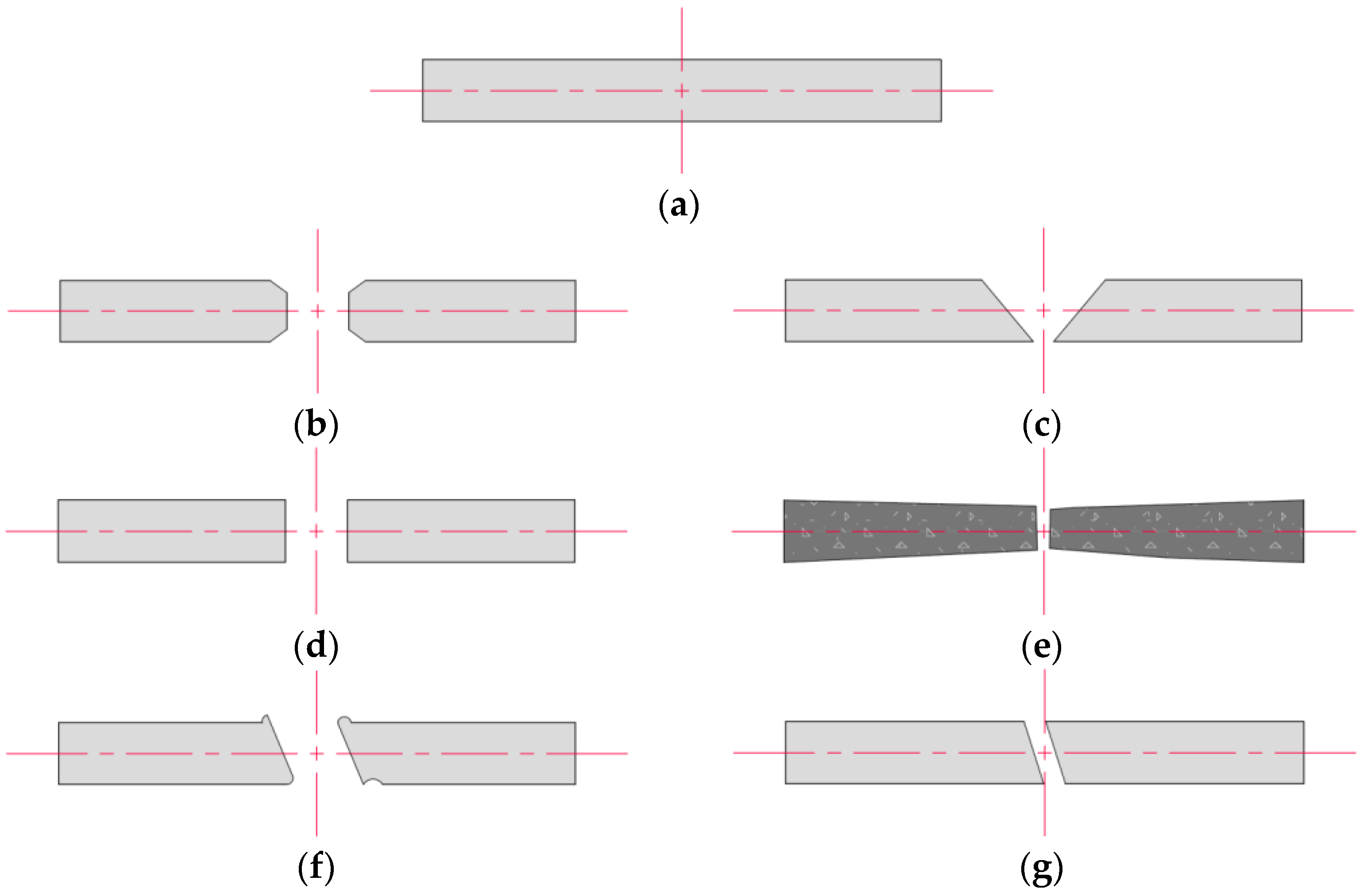
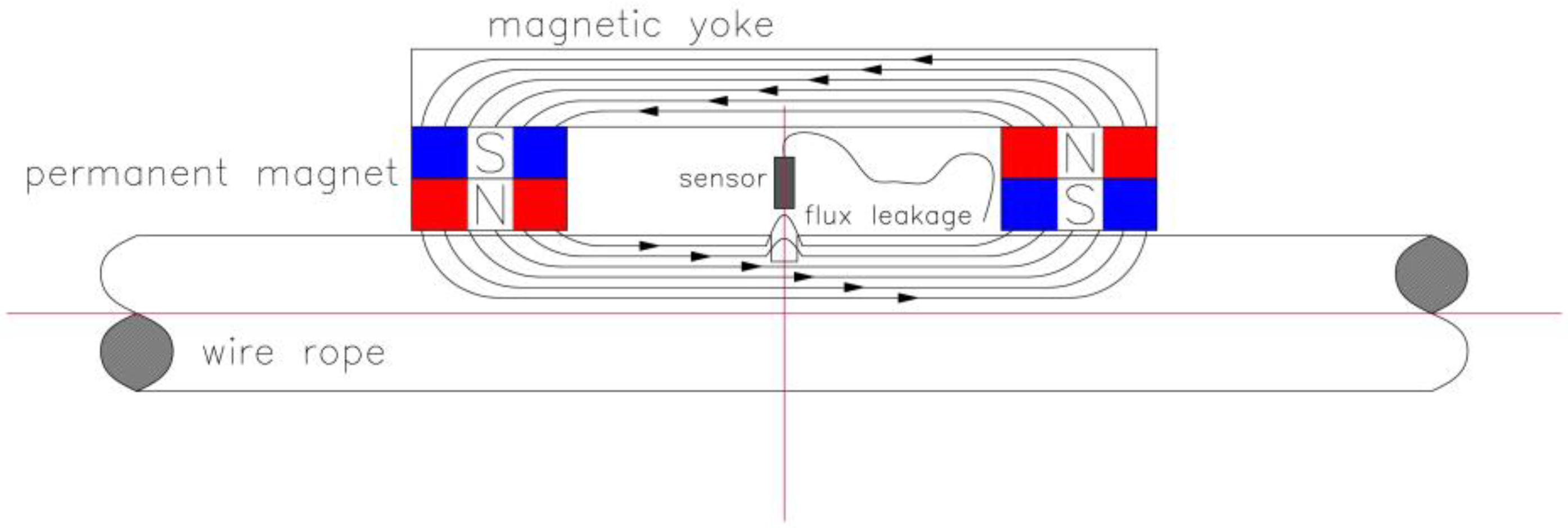
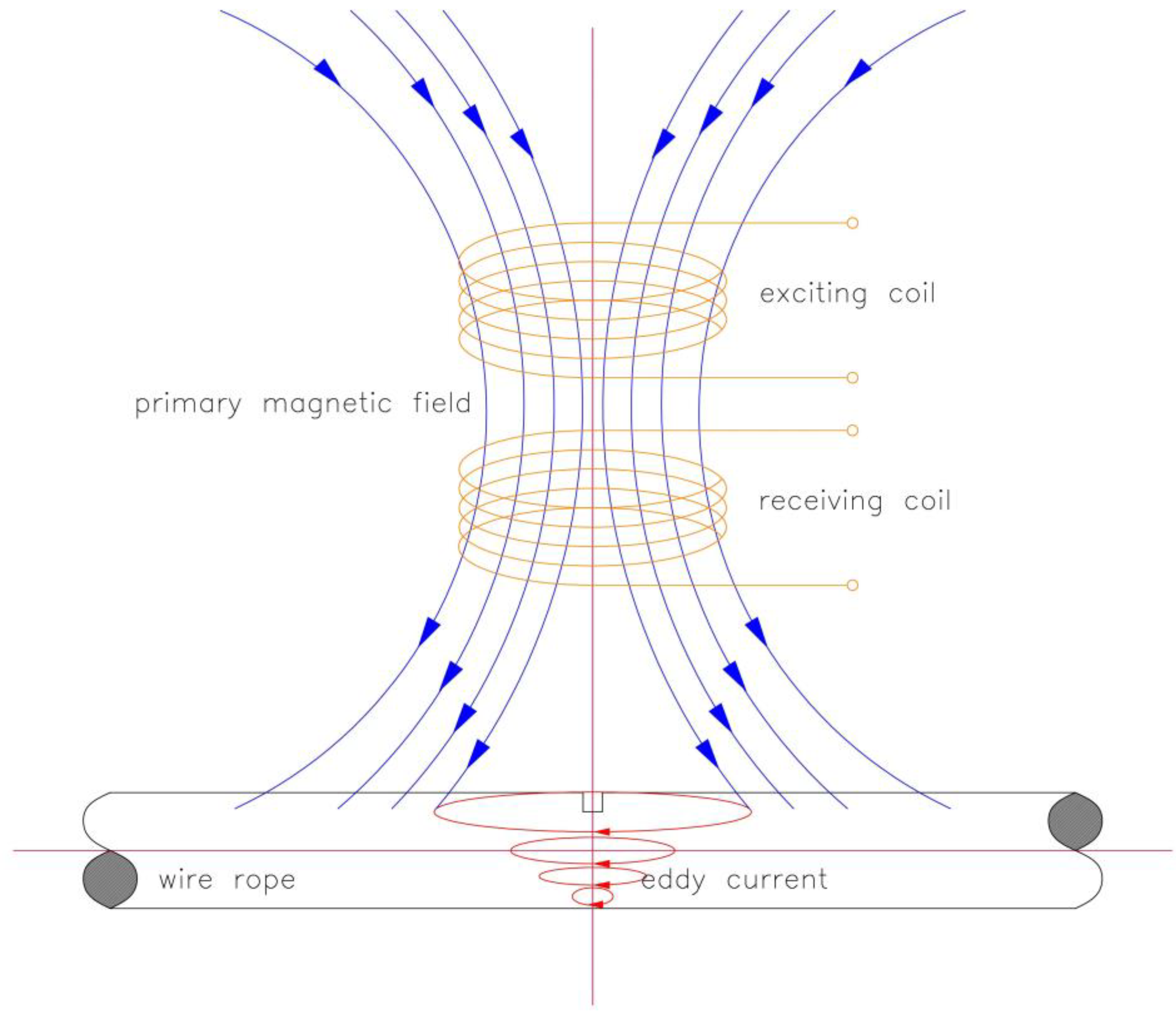


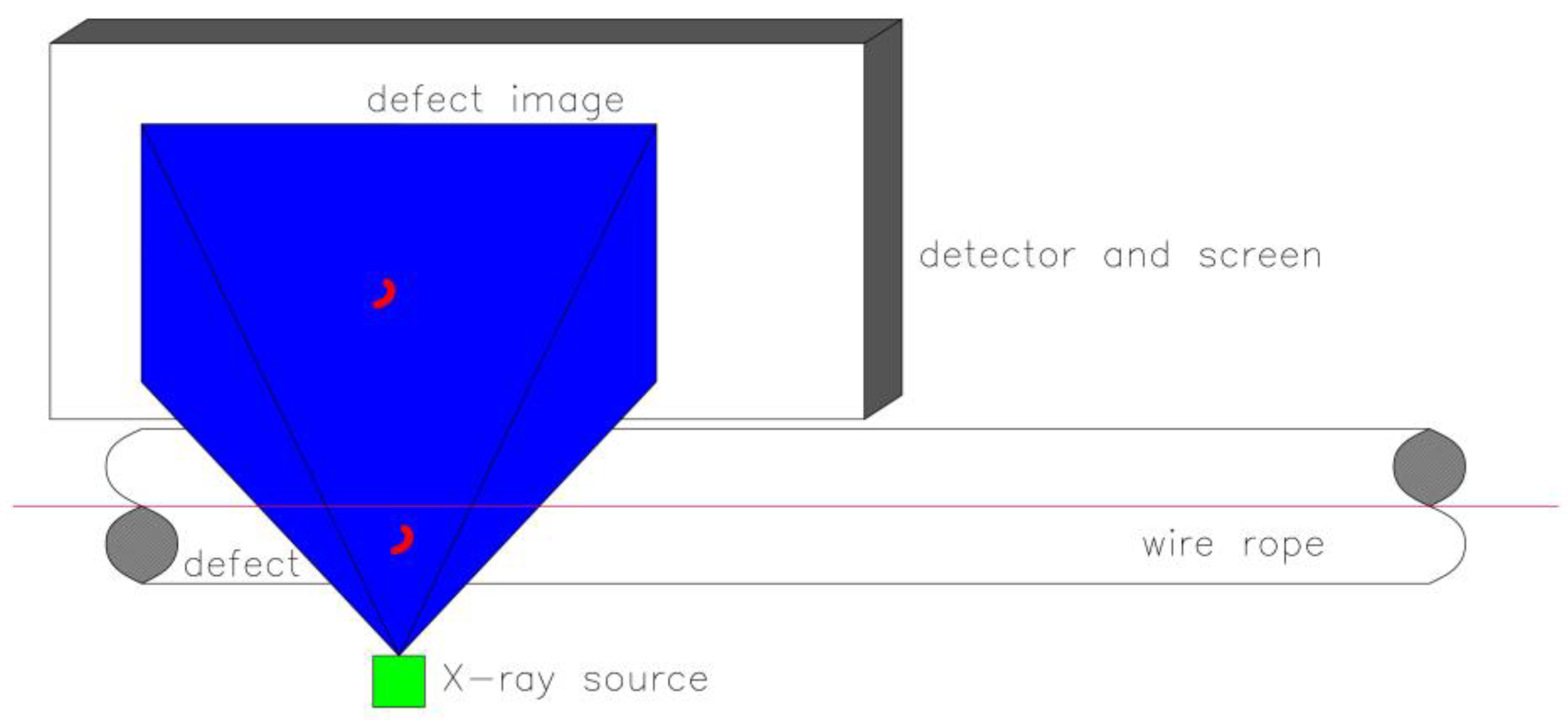


| Tension | Simple Bending | Reverse Bending | Rotary Bending | |
|---|---|---|---|---|
| Wire arrangements for testing |  | 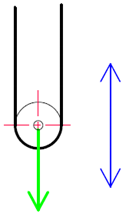 |  |  |
| Zone of maximum fluctuating stress |  | 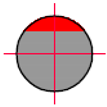 |  |  |
| Stresses | ||||
| Stress amplitude | ||||
| Middle stress | ||||
| Degradation Mechanisms | Main Causes | Dominant Parameter | Application Areas |
|---|---|---|---|
| Tension–tension fatigue | Changes in the axial tensile loading | Tensile load range | Lifting and hoisting applications, including mine hoisting |
| Bending-over-sheaves fatigue | Local changes in wire curvature as the rope adapts to the radius of a sheave or drum | The D/d ratio (the ratio of the sheave diameter to the rope diameter) Tensile load | Lifting and hoisting applications Mooring ropes |
| Free-bending fatigue | System dynamics or lateral oscillation | Tensile load | The cables of cable-stayed suspension bridges |
| Torsion fatigue | Absence of restriction on rotation under the attachments at either end No compliance with the restraint | Twist amplitude | Mooring of floating offshore systems Lifting and hoisting applications |
| Fretting fatigue | Friction between contacting wires | Coefficient of friction | All rope applications |
| Corrosion | Temperature, pollutants in the air and water | Water temperature | Mooring ropes The cables of cable-stayed suspension bridges |
| Wear | Friction between wires Bending of the rope | Coefficient of friction Bending stresses over sheaves or drums | Lifting and hoisting applications Mooring ropes |
| Method | Advantages | Disadvantages | Application Areas | Assessment |
|---|---|---|---|---|
| MFL |
|
|
| Quantitative assessment (the value of the difference in magnetic induction corresponds to the size of the damage) |
| ECT |
|
|
| Qualitative assessment |
| AE |
|
|
| Qualitative assessment |
| UGV |
|
|
| Qualitative assessment |
| Radiography |
|
|
| Qualitative assessment |
| VT |
|
|
| Qualitative assessment |
Disclaimer/Publisher’s Note: The statements, opinions and data contained in all publications are solely those of the individual author(s) and contributor(s) and not of MDPI and/or the editor(s). MDPI and/or the editor(s) disclaim responsibility for any injury to people or property resulting from any ideas, methods, instructions or products referred to in the content. |
© 2023 by the author. Licensee MDPI, Basel, Switzerland. This article is an open access article distributed under the terms and conditions of the Creative Commons Attribution (CC BY) license (https://creativecommons.org/licenses/by/4.0/).
Share and Cite
Mazurek, P. A Comprehensive Review of Steel Wire Rope Degradation Mechanisms and Recent Damage Detection Methods. Sustainability 2023, 15, 5441. https://doi.org/10.3390/su15065441
Mazurek P. A Comprehensive Review of Steel Wire Rope Degradation Mechanisms and Recent Damage Detection Methods. Sustainability. 2023; 15(6):5441. https://doi.org/10.3390/su15065441
Chicago/Turabian StyleMazurek, Paweł. 2023. "A Comprehensive Review of Steel Wire Rope Degradation Mechanisms and Recent Damage Detection Methods" Sustainability 15, no. 6: 5441. https://doi.org/10.3390/su15065441
APA StyleMazurek, P. (2023). A Comprehensive Review of Steel Wire Rope Degradation Mechanisms and Recent Damage Detection Methods. Sustainability, 15(6), 5441. https://doi.org/10.3390/su15065441







